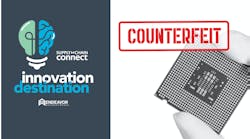The problem of counterfeit parts has worsened over the past 10 years, according to many buyers, distributors, and component manufacturers. The U.S. Department of Defense (DoD) agrees and recently finalized a rule that is designed to lessen the chance that counterfeit parts are used by defense contractors in military equipment.
The rule requires contractors and subcontractors to set up a counterfeit electronic part avoidance system, which is subject to audit and must include procedures to demonstrate that the contractors bought parts from original manufacturers, authorized distributors, or authorized aftermarket distributors before buying from other sources.
The new rule was put in place because studies show that counterfeit parts were being used in a variety of defense systems.
While the new DoD rule applies to the defense industry, counterfeit parts are an issue for consumer, industrial, medical, and other industries as well. In fact, power supply manufacturer RECOM recently issued a warning that the electronics market has been flooded by cheap copies of components, including counterfeit RECOM converters.
The bogus parts were knockoffs of RECOM’s DC-DC converters and were discovered when modules in a customer’s product failed. Testing showed that the DC-DC converters were counterfeit.
The company said it was trying to identify the counterfeiters and would take legal action against them. It also warned buyers to buy RECOM components only through authorized distributors, which is what authorized distributors have been saying for years. It is good advice, although it is not always followed by electronics purchasers—especially when parts are in short supply.
Robin Gray, chief operating officer and general counsel of the Electronic Component Industry Association (ECIA), has long advocated that buyers should purchase from authorized distributors or directly from component manufacturers. He says the counterfeit parts remain a major challenge for the industry and that counterfeiters are getting more sophisticated in their operations.
Gray said some counterfeiters steal the intellectual property for parts and then build unmarked clone components similar to the parts of a major semiconductor supplier or other component manufacturer. The parts are then shipped to other countries.
“All these clone parts come in with no markings so they aren’t stopped at the border,” he said. “It's one way to get by customs.”
Once the clones are in the country, someone packages them and puts a part number on them and they are sold as if they are original parts from a known manufacturer.
Much counterfeiting is done by organized crime, and some of it is state-sponsored, according to Gray. In fact, some counterfeiting is sponsored by terrorist groups, he said.
Buyers who feel they need to buy on the open market can borrow a page from distributors’ purchasing playbook. Authorized distributors will sometimes purchase parts on the open market when they have a bill of materials from a customer that they have to fill and don't have the parts in stock and can't find them from another authorized source. In such cases, the authorized distributors will purchase the components from independent distributors providing the parts can be traced back to the component manufacturer. If the parts can’t be traced to the original parts maker, the authorized distributor doesn’t buy them.







